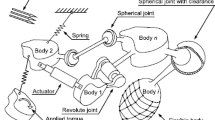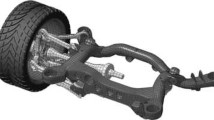Abstract
The use of multibody formulations based on Cartesian or naturalcoordinates lead to sets of differential-algebraic equations that haveto be solved. The difficulty in providing compatible initial positionsand velocities for a general spatial multibody model and the finiteprecision of such data result in initial errors that must be correctedduring the forward dynamic solution of the system equations of motion.As the position and velocity constraint equations are not explicitlyinvolved in the solution procedure, any integration error leads to theviolation of these equations in the long run. Another problem that isvery often impossible to avoid is the presence of redundant constraints.Even with no initial redundancy it is possible for some systems toachieve singular configurations in which kinematic constraints becometemporarily redundant. In this work several procedures to stabilize thesolution of the equations of motion and to handle redundant constraintsare revisited. The Baumgarte stabilization, augmented Lagrangian andcoordinate partitioning methods are discussed in terms of theirefficiency and computational costs. The LU factorization with fullpivoting of the Jacobian matrix directs the choice of the set ofindependent coordinates, required by the coordinate partitioning method.Even when no particular stabilization method is used, a Newton–Raphsoniterative procedure is still required in the initial time step tocorrect the initial positions and velocities, thus requiring theselection of the independent coordinates. However, this initialselection does not guarantee that during the motion of the system otherconstraints do not become redundant. Two procedures based on the singlevalue decomposition and Gram–Schmidt orthogonalization are revisited forthe purpose. The advantages and drawbacks of the different procedures,used separately or in conjunction with each other and theircomputational costs are finally discussed.
Similar content being viewed by others
References
Nikravesh, P.E., Computer-Aided Analysis of Mechanical Systems, Prentice Hall, Englewood Cliffs, NJ, 1988.
Petzold, L., Serban, R., Li, S., Raha, S. and Cao, Y., ‘Sensitivity analysis and design optimization of differential-algebraic equation systems’, in Computational Aspects of Nonlinear Structural Systems with Large Rigid Body Motion, J. Ambrósio and M. Kleiber (eds.), IOS Press, Amsterdam, 2001, 153–167.
Wehage, R. and Haug, E., ‘Generalized coordinate partitioning of dimension reduction in analysis of constrained dynamic systems’, ASME Journal of Mechanical Design 104, 1982, 247–255.
Baumgarte, J., ‘Stabilization of constraints and integrals of motion’, Conceptual Methods of Applied Mechanics and Engineering 1, 1972, 1–66.
Jalon, J. de and Bayo, E., Kinematic and Dynamic Simulation of Multibody Systems, Springer-Verlag, Heidelberg, 1993.
Arabyan, A. and Wu, F., ‘An improved formulation for constrained mechanical systems’, Multibody Systems Dynamics 2(1), 1998, 49–69.
Kim, S.S., Vanderploeg, M.J., ‘QR decomposition for state space representation of constrained mechanical dynamical systems’, ASME Journal of Mechanisms, Transmissions, and Automation in Design 108, 1986, 183–188.
Singh, R.P. and Likins, P.W., ‘Singular value decomposition for constrained dynamical systems’, Journal of Applied Mechanics 52, 1985, 943–948.
Meijaard, J.P., ‘Applications of the single value decomposition in dynamics’, Computer Methods in Applied Mechanics and Engineering 103, 1993, 161–173.
Udwadia, F.E. and Kalaba, R.E., Analytical Dynamics: A New Approach, Cambridge University Press, Cambridge, 1996.
Pina, H.L.G., Métodos Numéricos (NumericalMethods), McGraw-Hill, Lisboa, Portugal, 1995.
Author information
Authors and Affiliations
Rights and permissions
About this article
Cite this article
Neto, M.A., Ambrósio, J. Stabilization Methods for the Integration of DAE in the Presence of Redundant Constraints. Multibody System Dynamics 10, 81–105 (2003). https://doi.org/10.1023/A:1024567523268
Issue Date:
DOI: https://doi.org/10.1023/A:1024567523268




